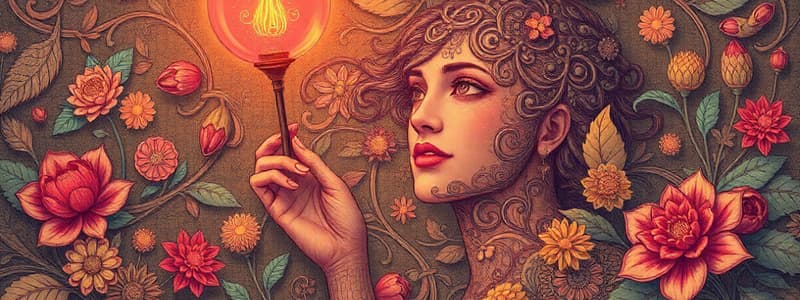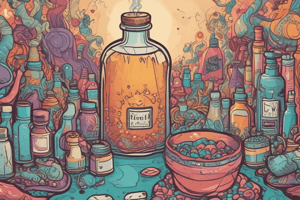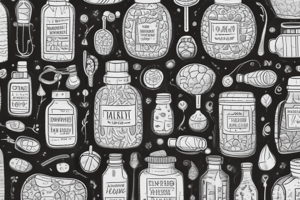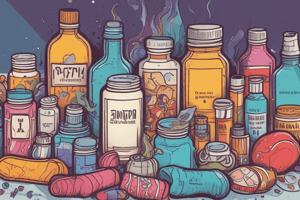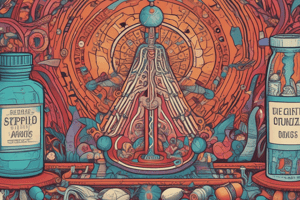Podcast
Questions and Answers
What is the primary psychoactive compound found in cannabis?
What is the primary psychoactive compound found in cannabis?
- THC (correct)
- Mescaline
- LSD
- Caffeine
The peyote cactus contains the active ingredient __________, which causes strong hallucinations.
The peyote cactus contains the active ingredient __________, which causes strong hallucinations.
mescaline
What is one of the uses of psychoactive drugs in human societies?
What is one of the uses of psychoactive drugs in human societies?
- Improving memory retention
- Hunger alleviation (correct)
- Weight loss
- Sports performance enhancement
Cannabis has been used as a fiber plant for only 1,000 years.
Cannabis has been used as a fiber plant for only 1,000 years.
Tobacco is not physiologically addictive.
Tobacco is not physiologically addictive.
What are mescal buttons?
What are mescal buttons?
What alkaloid is present in the solanaceous drugs that can cause hallucinations?
What alkaloid is present in the solanaceous drugs that can cause hallucinations?
The main ingredient in betel palm is the grated __________.
The main ingredient in betel palm is the grated __________.
Which of the following regions is known for tolerating personal cannabis consumption?
Which of the following regions is known for tolerating personal cannabis consumption?
Match the psychoactive drug with its description:
Match the psychoactive drug with its description:
Match the following cannabis forms with their descriptions:
Match the following cannabis forms with their descriptions:
Cannabis is fully legal in Canada and Uruguay.
Cannabis is fully legal in Canada and Uruguay.
Which of the following statements about nicotine is true?
Which of the following statements about nicotine is true?
Betel chewing can help prevent tapeworm infections.
Betel chewing can help prevent tapeworm infections.
Name one health effect of heavy cannabis use.
Name one health effect of heavy cannabis use.
What effect do morning glory seeds have on users?
What effect do morning glory seeds have on users?
What is a potential side effect of chewing betel palm?
What is a potential side effect of chewing betel palm?
Which psychoactive drug is known for having both stimulant and tranquilizing effects?
Which psychoactive drug is known for having both stimulant and tranquilizing effects?
What is the main danger associated with high doses of solanaceous tropane alkaloids?
What is the main danger associated with high doses of solanaceous tropane alkaloids?
Which of the following statements is true regarding tobacco use?
Which of the following statements is true regarding tobacco use?
What traditional use have morning glory seeds had among the Aztecs?
What traditional use have morning glory seeds had among the Aztecs?
What role did cannabis play in early 19th-century European art and literature?
What role did cannabis play in early 19th-century European art and literature?
Which of the following statements about the historical use of peyote cactus is true?
Which of the following statements about the historical use of peyote cactus is true?
What is one of the key concerns regarding heavy cannabis use?
What is one of the key concerns regarding heavy cannabis use?
Which factor contributed to the ban of cannabis in the 1930s in various regions?
Which factor contributed to the ban of cannabis in the 1930s in various regions?
What distinguishes the method of consuming cannabis known as hashish?
What distinguishes the method of consuming cannabis known as hashish?
Flashcards
What is Betel Palm?
What is Betel Palm?
A stimulant drug, used widely in India and Southeast Asia, that comes from the betel palm nut, is chewed with lime and spices, and causes discolored teeth and excessive spitting.
What is Tobacco?
What is Tobacco?
A physiologically addictive stimulant native to South America, belonging to the Tomato family, that is used worldwide. It is smoked, chewed, or snuffed and contains the addictive drug nicotine, which can be poisonous in large doses.
What are Solanaceous Drugs?
What are Solanaceous Drugs?
A group of hallucinogenic drugs found in plants of the Solanaceae (Tomato) Family, specifically the tropane alkaloids, like scopolamine. These alkaloids can cause a sensation of flying and are dangerous in high doses.
What are Alkaloids?
What are Alkaloids?
Signup and view all the flashcards
What is Nicotine?
What is Nicotine?
Signup and view all the flashcards
What is Areca Catechu?
What is Areca Catechu?
Signup and view all the flashcards
What are Lysergic Acid Derivatives?
What are Lysergic Acid Derivatives?
Signup and view all the flashcards
What is the Sensation of Flying?
What is the Sensation of Flying?
Signup and view all the flashcards
Mescaline
Mescaline
Signup and view all the flashcards
Cannabis
Cannabis
Signup and view all the flashcards
Tetrahydrocannabinol (THC)
Tetrahydrocannabinol (THC)
Signup and view all the flashcards
Hashish
Hashish
Signup and view all the flashcards
Cannabis Ban
Cannabis Ban
Signup and view all the flashcards
Cannabis Debate
Cannabis Debate
Signup and view all the flashcards
Medicinal Cannabis
Medicinal Cannabis
Signup and view all the flashcards
Cannabis Legalization
Cannabis Legalization
Signup and view all the flashcards
What are the active substances in Morning Glory?
What are the active substances in Morning Glory?
Signup and view all the flashcards
Study Notes
Psychoactive Drugs
- Psychoactive drugs, from plants and fungi, have long been used for rituals, alleviating hunger, and as stimulants, depressants, or hallucinogens
- Recreational and medicinal uses are often indistinguishable, as seen with cocaine
- Most psychoactive drugs are alkaloids that mimic, suppress, or enhance neurotransmission
Stimulant Drugs
- Betel Palm (Areca catechu):
- Widely used in India and Southeast Asia
- Grated nut mixed with lime and spices, wrapped in betel leaves and chewed
- Encourages excessive coughing, spitting, and discolors teeth
- Some evidence suggests it helps prevent tapeworm infections in tropical regions
- Tobacco (Nicotiana tabacum):
- Native to South America
- Physiologically addictive stimulant used worldwide
- First used in Central and South America ~1600 years ago
- Spread globally after 1500s
- Active drug nicotine is highly addictive and has both stimulant and tranquilizing effects
- Usually smoked, chewed, or snuffed
- Hand-picked and cured for quality
- More people are addicted to tobacco than any other natural product.
Hallucinogenic Drugs
- Solanaceous Drugs (Tomato Family):
- Some members produce hallucinogenic deliriant drugs, like scopolamine
- Scopolamine can cause a sensation of flying and potentially extreme nausea, convulsions, and death when taken in high doses.
- Morning Glory (Ipomoea violacea):
- Seeds contain lysergic acid derivatives causing nausea, vertigo, constipation and hallucinations
- Used by Aztecs in ceremonies
- Peyote Cactus (Lophophora williamsii):
- Native to northern Mexico
- Contains mescaline, a substance that causes strong hallucinations and nausea
- Used in religious ceremonies by Southwest North American natives
- Traded by North American natives as far north as southern Manitoba
Cannabis
- Cannabis (Cannabis sativa):
- Used in China and India for at least 3,000 years
- Used for making ropes, fish nets, clothing, paper, etc
- Seeds used as food; oil used in lamps and paints
- Medicinally used for pain relief and nausea, especially during chemotherapy
- Psychoactive compound is tetrahydrocannabinol (THC) found in female plants resin
- Various forms like sinsemilla, ganja, and hashish
- Popularization in Europe in 1840s, then spread to the United States
- Became popular in some circles in early 1900s
- Cannabis became banned in the U.S., Canada, Europe, and most other regions in the 1930s, often motivated by racist ideas.
- Legal status varies greatly around the world, even within countries
- Consumption is tolerated, sometimes legally, in some parts of the world, like Amsterdam, and Kashmir, while in other areas, like parts of India, it’s illegal.
Magic Mushrooms
- Magic Mushrooms (various species):
- Some mushroom species produce hallucinogenic effects when consumed in controlled doses
- Examples of genera include Stropharia, Psilocybes, Conocybe and Panaeolus
- Used in Native American ceremonies
- Used in northern Asia in communal rites.
Studying That Suits You
Use AI to generate personalized quizzes and flashcards to suit your learning preferences.
Related Documents
Description
Explore the world of psychoactive drugs, focusing on natural substances like the Betel Palm and Tobacco. This quiz highlights their uses, effects, and cultural significance across regions. Understand how these drugs interact with our brain's neurotransmission and their historical context.
